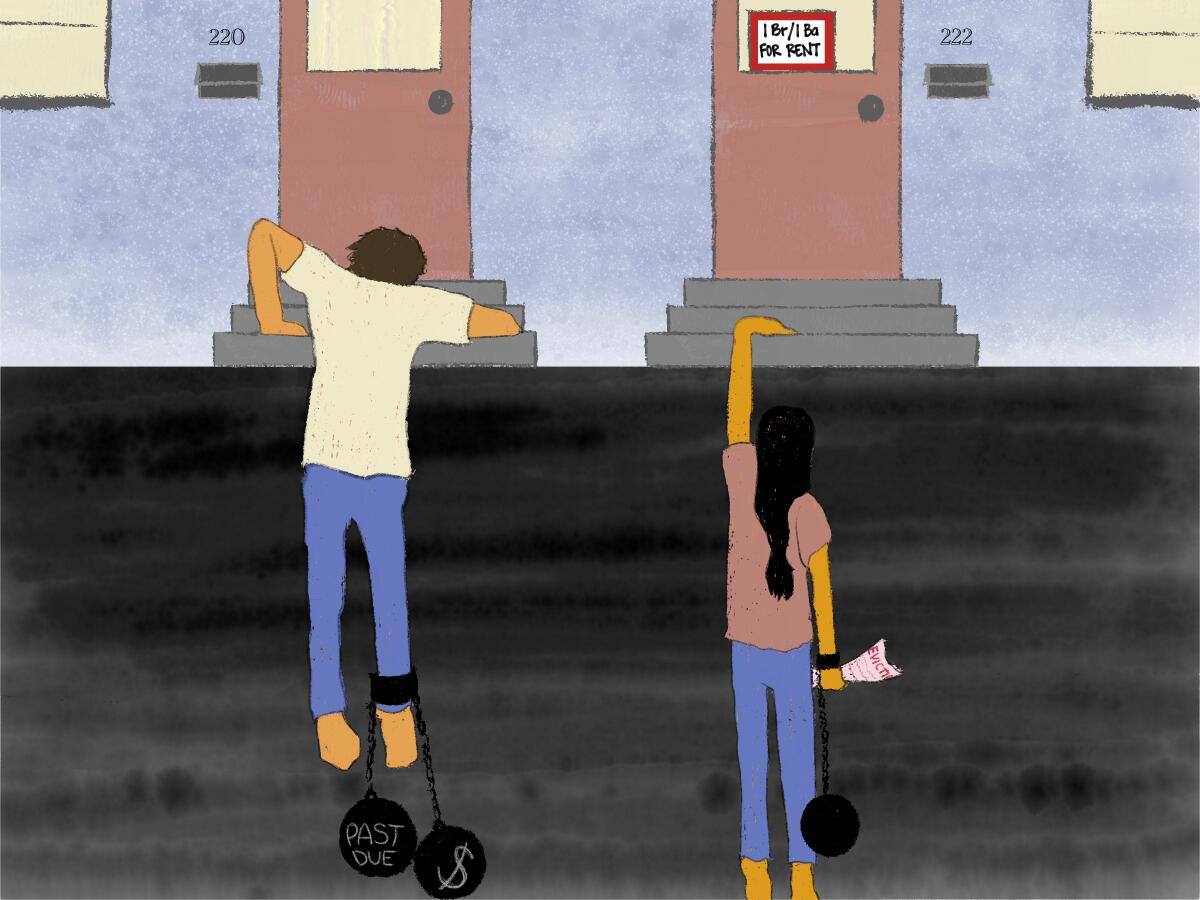Newsletter: What happens when the rent comes due?

Good morning. I’m L.A. Times Business reporter Andrew Khouri, filling in for Rachel Schnalzer to bring you our weekly newsletter.
The COVID-19 pandemic has caused millions of Americans to lose their jobs and made it difficult for people to pay all their bills. A series of eviction moratoriums — temporary rules that give tenants more ground to fight eviction — has kept roofs over many people’s heads. But that has not relieved tenants of the obligation to eventually pay the rent debt they’re accumulating.
Sooner or later, the moratoriums will end, smashing the current holding pattern. Here’s a look at this emerging problem and what may happen next.
Consider subscribing to the Los Angeles Times
Your support helps us deliver the news that matters most. Become a subscriber.
How big a problem is this?
Estimates vary on how much rent debt exists, and it’s difficult to know the true size and scope of the problem. Calculations so far are based on surveys and models rather than hard data because the pandemic economy and people’s circumstances are so fluid.
One report from Moody’s Analytics and the Urban Institute estimates that 9.4 million U.S. households owed an average of $5,586 each in back rent, utilities and related late fees as of January, for a total burden of $52.6 billion.
If I am not paying my rent, how could this affect me?
First, the eviction moratoriums eventually expire and require you to pay back what you owe. If you can’t pay then, you could be evicted.
Some landlords refuse to accept new tenants with an eviction on their record. Those who do accept them are likely to charge more, fail to keep up their properties and have units located in dangerous neighborhoods, according to housing attorneys and other experts.
Evictions also don’t automatically wipe away the debt you owe, and those past-due amounts can eventually end up on your credit report, harming your credit score.
Even if a person does not have an eviction on their record, debt and poor credit scores can damage their ability to find housing, often leading people to live in lower-quality conditions, said Ariel Nelson, an attorney with the National Consumer Law Center.
Poor credit scores also limit the ability to take out car, home and other loans at reasonable interest rates, putting homeownership further out of reach.
What is the federal government doing to help?
Congress last year approved $25 billion in rent and utility relief funds that states and some local governments are currently working to distribute to help low-income tenants and property owners.
President Biden has also proposed an additional $30 billion in rent and utility relief, and the Centers for Disease Control and Prevention recently extended a federal eviction moratorium for people with pandemic hardships until the end of March. However, tenant advocates say the federal eviction rules are weak.
What is California doing to help?
California just extended its own eviction moratorium for people with pandemic hardships. It now lasts until the end of June.
To avoid eviction in July, tenants need to pay that month’s rent as well as 25% of the rent they owed between September of last year through the end of June.
They still must pay back any other rent debt eventually, but landlords can’t evict for nonpayment of that outstanding amount. Instead, property owners can sue their tenants and hope to recover the money in court.
How does the California law protect tenants from accumulating rent debt?
The law contains several provisions to limit the amount of debt people owe to their landlords and cut down on long-term negative consequences.
The state is setting up a rent relief program funded through its share of the federal $25 billion.
Under the program, low-income tenants with pandemic hardships could see all the rent debt they accrued between April 1, 2020, and March 31, 2021, wiped away. For that to happen, a landlord must forgive 20% of the debt. If the landlord does so, federal money covers the remaining 80%.
If a landlord refuses, low-income tenants could receive federal money to cover 25% of their rent — the amount they must pay to avoid eviction in July. The landlord’s refusal also would give a judge the option to reduce the amount of rent the tenant owes.
What else should I know if I owe rent to my landlord?
Under California’s new rules, a prospective landlord can’t deny you housing because of rent debt accrued between March 1, 2020, and June 30, 2021.
Landlords also cannot sell or assign any rent debt accrued during the pandemic until July 2021. A spokesman for the state’s Business, Consumer Services and Housing Agency said the law goes even further for those who meet requirements for the state rental relief program: It forever bars landlords from selling their pandemic-induced rent debt, even if their landlord never participated in the program.
The debt selling prohibitions would prevent a primary way tenants’ credit scores could take a hit: Usually debt collectors, not landlords, are the ones who report to the credit bureaus, said Ariel Nelson, an attorney with the National Consumer Law Center.
Also, be aware that an eviction moratorium doesn’t forbid landlords from filing eviction cases. Tenants need to show up in court to defend themselves, Stephano Medina, an attorney with the Eviction Defense Network, told reporters recently.
Will the new state law work as planned?
Tenant advocates have raised concerns that some measures will be hard to enforce, and they worry about the optional nature of the rent relief program.
Sid Lakireddy of the California Rental Housing Assn., which represents landlords, said many landlords are likely to agree to forgive the 20% of rent because it would be hard to get more than the 80% the state is offering.
However, California’s rent-control laws may complicate a landlord’s decision, said Tina Rosales, a lobbyist with the Western Center on Law and Poverty. Longtime tenants in rent-controlled units often pay well below market rates, and under state law, when a rent-controlled unit becomes vacant, landlords can charge the next tenant as much as they want. So rather than forgiving 20% of a tenant’s debt and keeping the unit occupied, a landlord might prefer to let the debt build up and eventually pursue an eviction.
Anything else I should read?
An expanded version of this article, with more context, is here: What happens when all that rent comes due?
And if you’re thinking about moving, check out The Times’ guide to rental housing in Southern California.
Other stories you may find helpful
◆ President Biden has directed HealthCare.gov to take new applications for subsidized benefits. The new “special enrollment period” runs from Feb. 15 through May 15, the Associated Press reports. California’s health insurance marketplace, Covered California, is following suit. Its special enrollment period has already begun.
◆ Confused about what’s going on with GameStop and Robinhood? Sam Dean has you covered.
◆ We spoke with seven GameStop investors to understand their motives. Their responses ranged from “just for the fun” to “my goal is to bankrupt these billionaires.”
◆ Certified financial planner Liz Weston explains why trying to time the stock market is a really bad idea.
◆ California failed to heed warnings of unemployment benefit fraud for months, according to a state audit. Patrick McGreevy breaks down the findings.
◆ Despite Cal/OSHA’s emergency COVID-19 workplace safety rule, workers say little has changed. Jie Jenny Zou describes how several Cal/OSHA inspectors say their ranks remain thin despite the agency’s promises to scale up hiring.
◆ Before California eased pandemic restrictions last week, some business owners operated covertly. “It was just getting too hard to not work at all. Even when the government was giving us stimulus and unemployment, it wasn’t enough,” one business owner told Andrea Chang.
◆ Medicare said an outpatient sinus surgery was worth $5,869. Columnist David Lazarus explains how the hospital imposed a 1,200% markup on the procedure.
◆ Biden needs to clean house at the Social Security Administration, writes columnist Michael Hiltzik. He makes an argument for why the president must move quickly to get rid of Trump appointees.
One more thing
There’s not enough oxygen for COVID-19 patients in Southern California hospitals. “Our hospitals have never experienced this kind of strain on the oxygen supply chain,” one expert told my colleague Samantha Masunaga.
To address the problem, some companies are driving oxygen in from other states or increasing local production. To help in this process, California loosened regulations on how oxygen, oxygen equipment and other COVID-19 supplies are transported — including the limit on how long truck drivers can be on the road at a time.
But at least one part of the supply chain is intact: There’s no shortage of oxygen molecules. Factories just suck them in from the outdoors. Here’s the full story.
Have a question about work, business or finances during the COVID-19 pandemic, or tips for coping that you’d like to share? Send us an email at [email protected], and we may include it in a future newsletter.
Inside the business of entertainment
The Wide Shot brings you news, analysis and insights on everything from streaming wars to production — and what it all means for the future.
You may occasionally receive promotional content from the Los Angeles Times.





